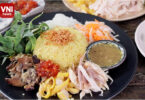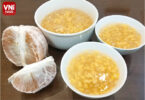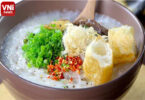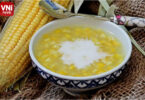Pandan Rice Cakes (Banh Duc La Dua) With Coconut Milk is delicious and easy to make. The beautiful green steamed rice cakes with greasy coconut milk and sweet jaggery are so hard to resist.
A Quick Story — and a Hint of Nostalgia
You know what’s funny? Every Vietnamese home seems to have its own version of bánh đúc. Some prefer the savory kind with minced pork and scallions; others — like this pandan version — are all about sweetness and coconut cream.
When I was little, my aunt used to pour the green batter into old metal molds and steam them on a charcoal stove. The air smelled of pandan leaves and sugar. I didn’t care much about the process; I just waited for that moment when she lifted the lid, and the steam carried that smell across the kitchen. That smell — that’s childhood in a breath.
Why You’ll Love This Recipe
- Simple ingredients, no fancy tools required.
- Soft, bouncy texture with a creamy coconut finish.
- Naturally fragrant from real pandan juice, no artificial flavoring.
- Perfect for family gatherings, afternoon tea, or just because you’re craving something comforting.
(Optional dietary note: Gluten-free, dairy-free if using plant-based coconut milk.)
Ingredients
(Makes about 8 servings)

For the Pandan Layer:
- 1 cup rice flour
- 3 tbsp tapioca starch (for that signature bounce)
- 1 ½ cups pandan juice (see note below)
- ½ cup coconut milk
- ⅓ cup sugar
- ¼ tsp salt
For the Coconut Layer:
- ¾ cup coconut milk
- 2 tbsp rice flour
- 2 tbsp tapioca starch
- 2 tbsp sugar
- ⅛ tsp salt
To Make Fresh Pandan Juice:
- Blend 6–8 pandan leaves (cut into 1-inch pieces) with 1 ½ cups of water.
- Strain the mixture using a cheesecloth or fine sieve.
- Let it sit for 10 minutes, and use the deep green layer that settles on top for the richest color.
💡 Tip: If you can’t find pandan leaves, use pandan extract — about 1 teaspoon per cup of liquid.
Step-by-Step Instructions
Step 1: Prepare the Ingredients
Start by washing about 100 grams of pandan leaves, then cut them into small pieces. Blend the leaves with 200 milliliters of water until smooth. Strain the mixture through a fine cloth or sieve to extract the deep green pandan juice — that’s where all the aroma lives.
Cut 100 grams of palm sugar into small chunks so it melts evenly later. Crush a small piece of fresh ginger, squeeze out the juice, and keep it aside — it’ll add a hint of warmth to the syrup later.

2. Make the Batter
In a pot, combine 450 milliliters of coconut cream, the fresh pandan juice, 120 grams of sugar, and ½ teaspoon of salt. Stir gently over low heat until the sugar fully dissolves.
In another bowl, sift together 180 grams of rice flour and 120 grams of tapioca starch. Gradually pour in the warm pandan–coconut mixture, whisking slowly until the batter turns smooth and glossy.
Let it rest for about 30 minutes. Then, place the pot over low heat and stir continuously until it thickens slightly and becomes heavier to stir — smooth but not solid. This step helps the final texture turn out perfectly soft and bouncy.

3. Steam the Cake
Lightly grease a round or square pan with a few drops of oil. Pour in the thickened batter and level it with a spatula.
Set up your steamer — water simmering gently, not boiling too fiercely. Place the pan inside, cover with a towel-wrapped lid to prevent condensation from dripping, and steam until firm and springy to the touch.
To test doneness, poke the center with a skewer — if it comes out clean, the cake is ready.

4.Make the Coconut Topping and Syrup
For the coconut topping:
In a small pot, mix 250 milliliters of coconut cream, a pinch of salt, and a few torn pandan leaves for extra fragrance. Heat gently until warm. In a separate cup, mix 1 teaspoon of tapioca starch with 2 tablespoons of water and pour it into the coconut mixture. Stir until it thickens to a creamy consistency — smooth, not lumpy.

For the palm-sugar syrup:
Combine 100 grams of palm sugar and 200 milliliters of water in a saucepan. Simmer until the sugar melts completely. Add the ginger juice and another pinch of salt for balance. Finally, stir in a tapioca slurry (1 teaspoon tapioca starch mixed with 2 tablespoons water) to slightly thicken the syrup. The color should turn a warm amber and smell gently of ginger.
5. Serve and Enjoy
Let the steamed cake cool for 15–20 minutes before unmolding. Slice it into neat squares or diamonds — you’ll see that delicate green glow from the pandan.
Spoon the coconut topping generously over each piece, then drizzle the golden syrup right before serving. The combination — silky pandan cake, rich coconut cream, and fragrant palm sugar — is pure comfort.
Enjoy it warm for the softest texture, or chilled for a firmer bite on a hot day.

Tips for Success
- Don’t overmix. Stir gently once the batter looks smooth — overmixing can make it dense.
- Mind the heat. Keep the steamer water at a simmer; a rolling boil may cause bubbles in the batter.
- Grease your pan well. It makes slicing and serving a breeze.
- Texture check: The cake should jiggle softly when shaken, not wobble like jelly.
Storage & Leftovers
You can keep the cake in an airtight container in the refrigerator for up to 3 days.
To reheat, steam for 3–4 minutes or microwave with a damp paper towel.
Freezing isn’t ideal — it can alter the texture, making it a little rubbery.
FAQs
- Can I make this ahead of time?
Yes, absolutely. You can make it the day before and chill it overnight. Just steam briefly before serving to restore softness. - Can I use pandan extract instead of fresh leaves?
Yes, but use it sparingly — extracts are often concentrated. Start with ½ teaspoon per cup of liquid. - Is it sweet?
Just lightly. The goal is balance — subtle sweetness, creamy finish, fragrant aroma. - Can I replace coconut milk with something else?
You can try soy milk or oat milk for a lighter version, but the richness won’t be quite the same. Coconut milk is the heart of the flavor here.
Nutrition Info Per Serving
- Calories: 180
- Carbohydrates: 25g
- Fat: 7g
- Protein: 2g
- Sodium: 70mg
(Low in cholesterol and gluten-free — a guilt-free indulgence!)
The Heart Behind the Flavor
Here’s the thing — desserts like this aren’t just recipes. They’re little time capsules. Every spoonful of pandan rice cake carries the warmth of coconut milk and the rhythm of family kitchens across Southeast Asia.
It’s not just a sweet. It’s a memory — of laughter, humidity, fans whirring, someone shouting from the yard, “The cake’s ready!”
Maybe that’s why people keep coming back to it. Not because it’s trendy or fancy — but because it feels like home.








